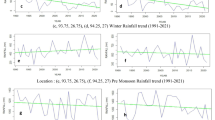Abstract
The 13 provinces (autonomous regions and municipalities) in northern China are located in latitude 31°–54°N and longitude 73°–136°E including Beijing, Tianjin, Hebei, Shanxi, Inner Mongolia, Jilin, Liaoning, Heilongjiang, Shaanxi, Gansu, Ningxia, Qinghai, and Xinjiang, where environments are fragile. In recent years, the eco-environmental problems such as vegetation destruction, desertification and soil erosion etc. become serious because of climate change and unreasonable human activities. In this paper, landscape pattern and its evolution in northern China from 1989 to 2003 was investigated by the combined use of RS and GIS based on the basic theory and method of landscape ecology. Land use/cover maps of the study area in 1989, 1999 and 2003 were produced by using 1 km monthly NOAA Advanced Very High Resolution Radiometer (AVHRR) and SPOT/VGT Normalized Difference Vegetation Index (NDVI) dataset from national climate bureau of China which were geo-registered to Lambert azimuthal equal-area map projection and were used in the paper. Landscape evolution in the area over the study period was investigated by two methods: (a) the changes of various landscape metrics were analyzed using the landscape structure analysis program FRAGSTATS; (b) the transition matrix of landscape patch types was calculated with the help of the RS and GIS software. The results showed that from 1989 to 2003, the landscape within the study area had undertaken a complicated evolution in landscape structure and composition. The diversity index and evenness index increased during the period, which means that the landscape pattern tended to be diversified and even. The fragmentation index of grassland, forestland and water areas also increased significantly. This showed that the distribution and structure of forestland, grassland and water areas had been changed greatly during the period, especially grassland which became more and more fragmentized, and its fragmentation index increased from 19.23% to 88.72%. The transitions of the landscape types were mainly shown by the changes among forestland, grassland and farmland, and grassland changing into unable land. Over the study period, grassland and water areas had decreased remarkably, accounting for 15% and 37% from 1989 to 1999 and 24.79% and 49.25% from 1999 to 2003 respectively. The grassland and water resources play an important role in the eco-environment and economic development of the region. So, they must be protected carefully. According to the analysis, we can conclude that the eco-environment in the study area is obviously degenerated due to unreasonable human activities and climate changes and some measures should be taken to combat the environ-mental degradation.
Similar content being viewed by others
References
Antrop M, 2000. Background concepts for integrated landscape analysis. Agriculture, Ecosystems and Environment, 77: 17–28.
He Chunyang, Shi Peijun, Chen Jin et al., 2001. A study on land use/cover change in Beijing area. Geographical Research, 20(6): 679–687. (in Chinese)
Huang Junfang, Wang Ranghui, Shi Qingdong, 2004. RS/GIS-based analysis on the ecological landscape patterns in the Sangong river basin, Xinjiang. Arid Zone Research, 21(1): 33–37. (in Chinese)
Li Jinggang, He Chunyang, Shi Peijun et al., 2004. Change process of cultivated land and its driving forces in northern China during 1983–2001. Acta Geographica Sinica, 59(2): 274–282. (in Chinese)
Li Xiaobing, Chen Yunhao, Wang Hong et al., 2004. Regional distribution of land cover change amplitude in China. Scientia Geographica Sinica, 24(3): 270–274. (in Chinese)
Li Xin, Lu Ling, Cheng Guodong et al., 2001. Quantifying landscape structure of the Heihe River Basin, North-west China using FRAGSTATS. Journal of Arid Environments, 48: 521–535.
Li Z, Li X, Wang Y et al., 2004. Land use change analysis in Yulin prefecture, northwestern China using remote sensing and GIS. International Journal of Remote Sensing, 25: 5697–5703.
Lu Ling, Li Xin, Cheng Guodong, 2003. Landscape evolution in the middle Heihe River Basin of north-west China during the last decade. Journal of Arid Environments, 53: 395–408.
Pan Yaozhong, Li Xiaobing, Gong Peng et al., 2003. An integrative classification of vegetation in China based on NOAA AVHRR and vegetation-climate indices of the Holdridge life zone. International Journal of Remote Sensing, 24: 1009–1027.
Shi Peijun, 1997. Today and future of the dynamics of human-earth (earth surface) system. Earth Science Frontiers, 4: 201–202. (in Chinese)
Tucker C J, Townshend J R G, Goff T E, 1985. African land-cover classification using satellite data. Science, 227: 369–375.
Wan Jun, Cai Yunlong, Zhang Huiyuan, 2000. The study on the landscape change in karst mountain area using TM image. Journal of Mountain Science, 18: 18–25. (in Chinese)
Xue Hui, Wang Jiaji, 1993. The Theory and Application of Landscape Ecology. Beijing: China Environmental Science Press, 129–209. (in Chinese)
Yu Xingxiu, Yang Guishan, Wang Yao, 2004. Advances in researches on environmental effects of land use/cover change. Scientia Geographica Sinica, 24(5): 627–633. (in Chinese)
Zhang Ming, 2000. A study on the landscape pattern and differentiation of fragile environment in Yulin Prefecture. Geographical Research, 19: 30–36. (in Chinese)
Author information
Authors and Affiliations
Corresponding author
Additional information
Foundation: Science & Technology Research Project of Chongqing Municipal Education Commission, No.KJ070811; Doctor Startup Fund of Chongqing Normal University, No. 06XLB004; National Basic Research Program of China, No.G2000018604
Author: Li Yuechen (1974–), Ph.D and Associate Professor, specialized in the study of remote sensing application and land use/land cover change.
Rights and permissions
About this article
Cite this article
Li, Y. Land cover dynamic changes in northern China: 1989–2003. J. Geogr. Sci. 18, 85–94 (2008). https://doi.org/10.1007/s11442-008-0085-6
Received:
Accepted:
Published:
Issue Date:
DOI: https://doi.org/10.1007/s11442-008-0085-6




